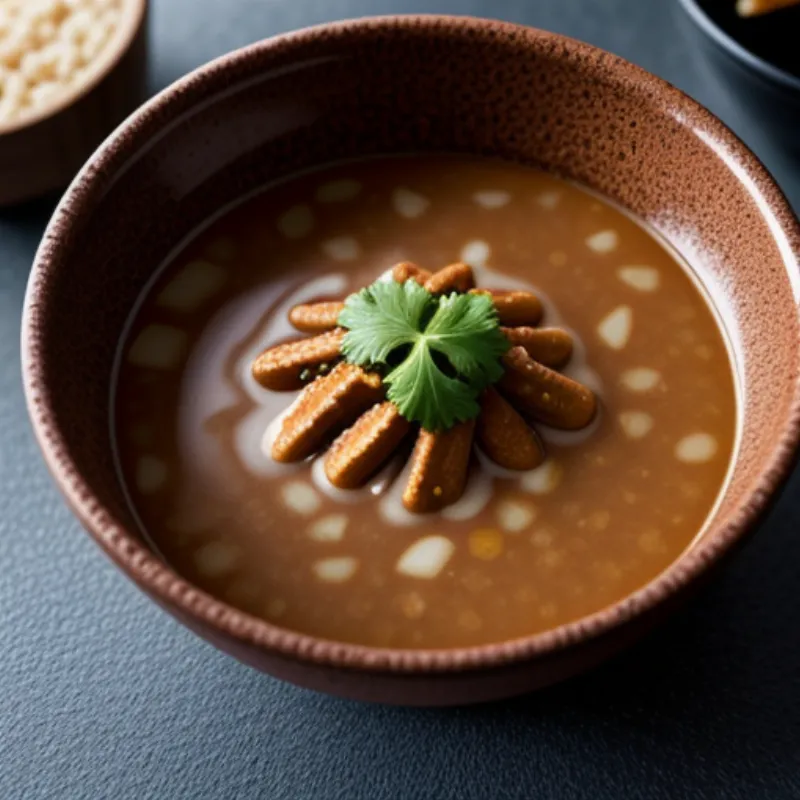Doenjang, a pungent and savory fermented soybean paste, is a cornerstone of Korean cuisine. This umami-rich ingredient adds depth and complexity to stews, soups, marinades, and dipping sauces. Today, we’ll embark on a culinary adventure to discover the art of making doenjang at home, unlocking the secrets to its unique flavor. Get ready to impress your taste buds with a taste of Korea’s rich culinary heritage!
A Glimpse into Doenjang’s Rich History
Doenjang boasts a rich history dating back centuries in Korea. Traditionally crafted in Korean households, its roots run deep in Korean culture. Imagine generations passing down their cherished doenjang recipes, ensuring this flavorful paste graces family tables for years to come. “Jangdokdae,” earthenware crocks dedicated to fermenting doenjang and other Korean staples, stood as testaments to the importance of this process.
Why Make Your Own Doenjang?
You might wonder, “Why make doenjang when I can easily buy it?” Well, crafting your own doenjang is an incredibly rewarding experience. Here’s why:
- Unmatched Flavor: Homemade doenjang possesses a depth of flavor that surpasses store-bought versions. You control the ingredients and the fermentation process, resulting in a truly unique and delicious paste.
- Connection to Tradition: Making doenjang connects you to Korean culinary traditions, allowing you to appreciate the time-honored techniques that have been passed down through generations.
- Natural and Preservative-Free: By making your own, you avoid any unnecessary additives or preservatives that might be present in commercial products.
Gathering Your Doenjang Making Supplies
Ingredients:
- Soybeans: 2 cups, preferably organic and non-GMO
- Sea Salt: 1 cup, coarse
- Water: As needed
Equipment:
- Large pot
- Cheesecloth
- Strainer
- Sterilized jar (or traditional earthenware crock if available)
A Step-by-Step Guide to Homemade Doenjang
-
Prepare the Soybeans: Rinse the soybeans thoroughly and soak them in cold water for at least 12 hours or overnight. This rehydrates the beans and aids in the fermentation process.
-
Cook the Soybeans: Drain the soaked soybeans and place them in a large pot. Cover with water, ensuring the water level is a few inches above the beans. Bring to a boil, then reduce heat and simmer for 3-4 hours, or until the soybeans are soft enough to crush easily between your fingers.
-
Form the Meju: Line a strainer with cheesecloth and place it over a large bowl. Carefully pour the cooked soybeans into the strainer, allowing the excess water to drain. Once cooled, transfer the soybeans to a clean work surface and mash them into a paste-like consistency. Form the mashed soybeans into rectangular blocks called “meju.”
-
Drying and Fermenting the Meju: Thread a string through the meju blocks and hang them in a well-ventilated, sunny spot for 4-6 weeks to dry. This drying process is crucial for developing the characteristic flavor and aroma of doenjang. As the meju dries, it will develop a white mold on the surface. This mold is beneficial and a natural part of the fermentation process.
-
Brining the Meju: After drying, gently brush off any excess mold from the meju. Sterilize a large jar and add the dried meju blocks. Dissolve the sea salt in water and pour the brine over the meju, ensuring they are fully submerged. Seal the jar tightly.
-
Patiently Waiting for Fermentation Magic: Store the jar in a cool, dark place for at least 2-3 months, or longer for a more intense flavor. During this time, the meju will continue to ferment, developing the rich, savory, and umami notes that define doenjang.
-
Separating the Doenjang and Ganjang: After the desired fermentation time, carefully remove the meju blocks from the brine. The liquid brine is now a flavorful soy sauce known as “ganjang.” The softened meju blocks are your prized doenjang.
 Making Doenjang
Making Doenjang
Tips for Doenjang Success:
- Salt Ratio Matters: Using the correct salt-to-soybean ratio is crucial for proper fermentation and preventing spoilage.
- Embrace the Mold: Don’t be alarmed by the white mold that forms on the meju during drying. This mold is beneficial and contributes to the unique flavor of doenjang.
- Time is Your Friend: Doenjang’s flavor deepens and intensifies with time. Don’t hesitate to experiment with longer fermentation periods for a richer taste.
FAQs About Making Doenjang:
Q: Can I use different types of soybeans?
A: While Korean soybeans are traditional, you can use other soybean varieties. However, the flavor may vary slightly.
Q: What if I don’t have a sunny spot for drying the meju?
A: You can use a food dehydrator at its lowest setting to mimic the drying process.
 Doenjang in a bowl
Doenjang in a bowl
Exploring the Culinary Versatility of Doenjang:
Now that you’ve mastered the art of making doenjang, let’s explore its culinary possibilities. Here are some ideas:
- Doenjang Jjigae (Doenjang Stew): A comforting and flavorful Korean stew that showcases doenjang’s savory depth.
- Doenjang Glaze: A fantastic glaze for grilled meats or vegetables, adding a touch of umami and complexity.
- Dipping Sauce: Combine doenjang with sesame oil, gochujang (Korean chili paste), and toasted sesame seeds for a delicious dipping sauce for vegetables, dumplings, or grilled meats.
For those who love exploring Korean flavors, you might also enjoy learning how to make gochujang dressing, another staple in Korean cuisine.
The Joys of Homemade Doenjang:
Making your own doenjang is a labor of love but incredibly rewarding. The process connects you to Korean culinary traditions, fills your kitchen with enticing aromas, and ultimately culminates in a taste that is well worth the wait. So, embark on this culinary adventure and savor the satisfaction of creating your own jar of this flavorful fermented soybean paste!
